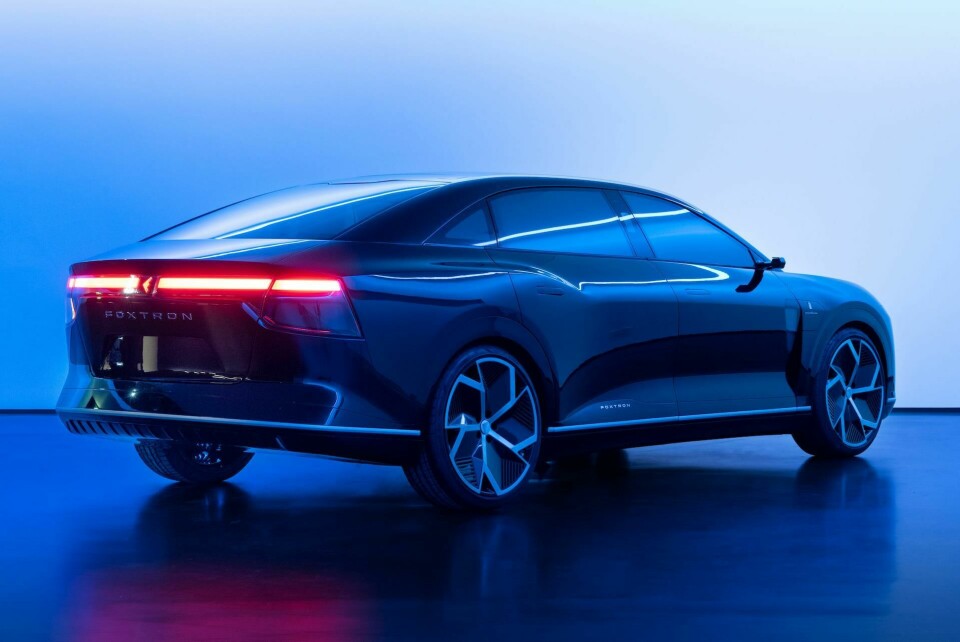
Pininfarina and Foxconn to take on EV market
Designers at Pininfarina and Foxconn, with experience in the car and tech industries, have come together to create a prototype electric sedan
Italian design firm Pininfarina has teamed up with one of the largest technology companies in the world to create a prototype electric sedan, taking the fight to traditional carmakers. Foxconn is behind the iPad, iPhone, iPod, Kindle, BlackBerry, Nintendo devices, Nokia devices, Sony devices, Google Pixel devices and much more. Lending its weight to the car industry, and working alongside the legendary Pinin, could be an extremely significant step in the next phase of EV design.
The Model E was unveiled at the Hon Hai Technology Day – an event hosted by Foxconn in Taipei, Taiwan. It is clean and clinical in its exterior design, with neat lines and body work keeping everything in check. A lightbar runs across the front of the car, giving the front end a distinctive look. It is positioned above two vertical air intakes that sit at the very edges of the front end and the middle air intake with the silver “FOXTRON’ lettering at the centre. At the very bottom there is a thin strip of chrome, which continues along the sides and rear of the car, tying everything together.
A low-running shoulder line emphasises the protruding rear wheels, and links up to the light bar that runs along the back. There is also a strong and clean belt line, with roof gently sloping as the large back window and C pillars fall to meet a curvy upper section of body work above the rear lightbar. This pushes back and finishes in a sharp lip, with the rest of the back tapering towards the rear wheels to almost create a negative angle. The result is a very distinctive looking, wedge-like rear.
Careful attention has been paid to make the interior as clean and luxuriousness as possible. There is no clutter in the way of buttons, switches and visible vents. Instead, everything is hidden in a layered IP, which is only adorned with a large screen unit. This wraps around behind the driver wheel and finishes above the centre console. Aside from a few touch-sensitive buttons on the steering wheel, this large screen unit seems to be the only way to interact with the vehicle and its systems.
There is a focus on using plush materials, with the large lower section of the IP finished in the same white leather that features on the doors, centre console and seats. There is also a wooden panel on the IP, some glossy surfaces, and touches of chrome. An injection of colour comes from ambient lighting on the IP, doors and centre console.
The back seats can be turned into what Foxconn calls an “exclusive mobile office”. A rotating mount for a large touchscreen is positioned in between the two back seats, and technologies like facial recognition allow occupants to interact with the vehicle.
But not content on just the one car, Foxconn unveiled two other models at the same event that it has developed without the help of the Italian design firm. Dubbed Model C, the compact SUV reportedly has a drag coefficient of 0.27 – far better than the figure typically achieved by most SUVs, which sits between 0.35-0.45. It also boasts a range of 700km (435 miles) on a single charge – easily outstripping the 300 miles achievable by the Car Design Review Production Car of the Year 2021, the Hyundai Ioniq 5. Like the Model E, this SUV comes with a light bar that stems the width of the fascia. But underneath, two sharp C-shaped air intakes are positioned in front of the wheels and provide the Model C with a menacing stance.
The third model Foxconn unveiled takes a completely different design approach. The Model T is an electric bus designed to meet regulatory standards in the US, having undergone over 1,000 hours of strength tests and covered over 200,000km in durability tests. It is simple in its form, with curved corners giving character to an otherwise long and clean shape. The upper is almost entirely made of glass, while a narrow panel of sheet metal wraps around the lower to encase the wheels and lights.
Foxconn’s move into the electric vehicle market, and particularly its collaboration with Pininfarina, signals an important moment in the world of car design. With an increasing focus on the vehicle interior and UX technologies, design teams can likely lean on and use the extensive knowledge and expertise gained by giants like Foxconn to push the boundaries of design.
Pininfarina has been busy of late. The firm used the last Car Design Dialogues Asia event to unveil its Teorema concept – fully autonomous electric vehicle that was designed to showcase ideas for making driving and travel within a vehicle exciting and fun.















